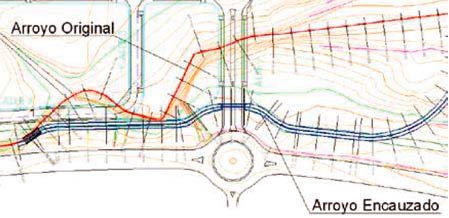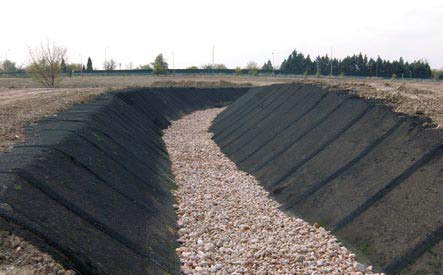Barajas Airport Development
Description of social and environmental performance.
Problem detected:
The development of the zone made it necessary to alter the course of the Rejas Stream, a tributary of the River Jarama, so as not to interfere with the planning proposed in the Development Plan of the Madrid-Barajas Air Cargo Centre-South (CCAMB). Because the stream crossed commercial sites of CCAMB-South, it was decided to alter its course, channelling it through a trapezoidal-section channel. The new route runs parallel to the service road of the Nacional II Road, then it diverts to the north and finally it flows into the existing channelling next to the Airport site. Channelling the Stream solved the land planning problem, but the project did not define its environmental treatment, which was essential to ensuring its landscape integration.
Solutions adopted:
As a proposal for the original project, FCC Construccion suggested the ecological channelling of the Rejas Stream, and it was decided to use a geogrid and then hydro-seed the area. A three-dimensional geogrid was selected, thus facilitating the vegetation growth through it; and besides it has anti-erosion and soil protection properties. To execute the ecological channelling works, firstly the excavation necessary for the channel geometry was carried out; then the geogrid was laid down on the excavated slopes and the channel bottom was upholstered with gravel. Finally the slopes were hydro-seeded.
Results:
- The geogrid is an ecological and affordable solution, as the visual impact is minimal compared with conventional solutions used for streams channelling, such as rockfill or concrete. Furthermore, it constitutes a permanent reinforcement system for the roots of plants and a comprehensive and effective erosion control system.
- Other environmental benefits of the solution adopted are the creation of new habitats for plant and animal species - as it facilitates the biological development of the stream – as well as the non-toxicity of the materials used in the geogrid, which prevents damage to the environment.
- Its quick and easy fixing using metal pegs, the easy handling and the superb performance during installation also make it a profitable option from the economic point of view, thanks to reduced costs and lead times compared to other more conventional systems.
- We can therefore conclude that the solution implemented has achieved optimal adaptation to the environment, thus enabling the ecological balance to be re-established quickly and efficiently after completion the works.

Route of the original stream and of the new stream channelling, as a consequence of the development of the land (Arroyo original = original stream route; Arroyo encauzado = stream channelled)

Channelling of the Rejas Stream, with gravel at the channel bottom and slopes upholstered with geogrid hydro-seeded.








